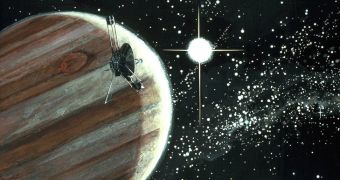Tomorrow will mark the 40th anniversary of the launch of the Pioneer 10 spacecraft, which was the first man-made vehicle to fly through the Inner Asteroid Belt (IAB). The probe took off on March 2, 1972, and endured in space for decades.
The spacecraft is the first interplanetary mission that was sent to Jupiter, and is also the first vehicle ever made to accelerate so fast that it eventually achieved escape velocity in respect to the solar system.
Pioneer 10 was managed by the NASA Ames Research Center (ARC), in Moffett Field, California. It took off at 01:49:00 UTC, from the Cape Canaveral Air Force Station's (CCAFS) Space Launch Complex 36A, aboard an expendable Atlas/Centaur delivery system.
Due to its enormous power plant, made up of four SNAP-19 radioisotope thermoelectric generators (RTG), the spacecraft was able to operate for a total time of 30 years, 10 months, and 22 days, between March 2, 1972 and January 23, 2003.
The probe was relatively small by today's standards, with a total mass of 258 kilograms (570 pounds). Despite its relative small size, Pioneer 10 carried a suite of 11 main scientific instruments. It used them all during its Jupiter flyby, which concluded on January 1, 1974.
According to NASA, the point of closest approach was reached on December 3, 1973, when the vehicle passed just 81,000 miles (130,357 kilometers) above Jupiter's cloud cover.
NASA estimates that Pioneer 10 traveled in excess of 8 billion miles (12.87 billion kilometers), covering a total distance of about 70 astronomical units. An AU is the mean distance between the Earth and the Sun.
In a sense, this mission truly was a path-opener for all the other interplanetary exploration efforts conducted at NASA. The Voyager probes, the Ulysses mission, the Jupiter-bound Galileo spacecraft and the Cassini orbiter (which is orbiting Saturn even now) all had to benefit from lessons learned during the Pioneer 10 endeavor.
Without the radiation readings collected by the spacecraft around Jupiter, designing Voyager and Galileo would have been a lot harder, if not impossible. “Pioneer 10 made valuable scientific investigations in the outer regions of our solar system until the end of its science mission on March 31,1997,” a NASA press release explains.
“After more than 30 years, it appears the venerable Pioneer 10 spacecraft has sent its last signal to Earth. Pioneer's last, very weak signal was received Jan. 23, 2003. The power source on Pioneer 10 finally degraded to the point in 2003 where its signal to Earth dropped below the threshold for detection,” the document adds.
About 2 million years from now, the Pioneer 10 spacecraft may enter orbit around the red star Aldebaran, which is located around 68 light-years away, and forms the eye of Taurus (The Bull).

 14 DAY TRIAL //
14 DAY TRIAL //